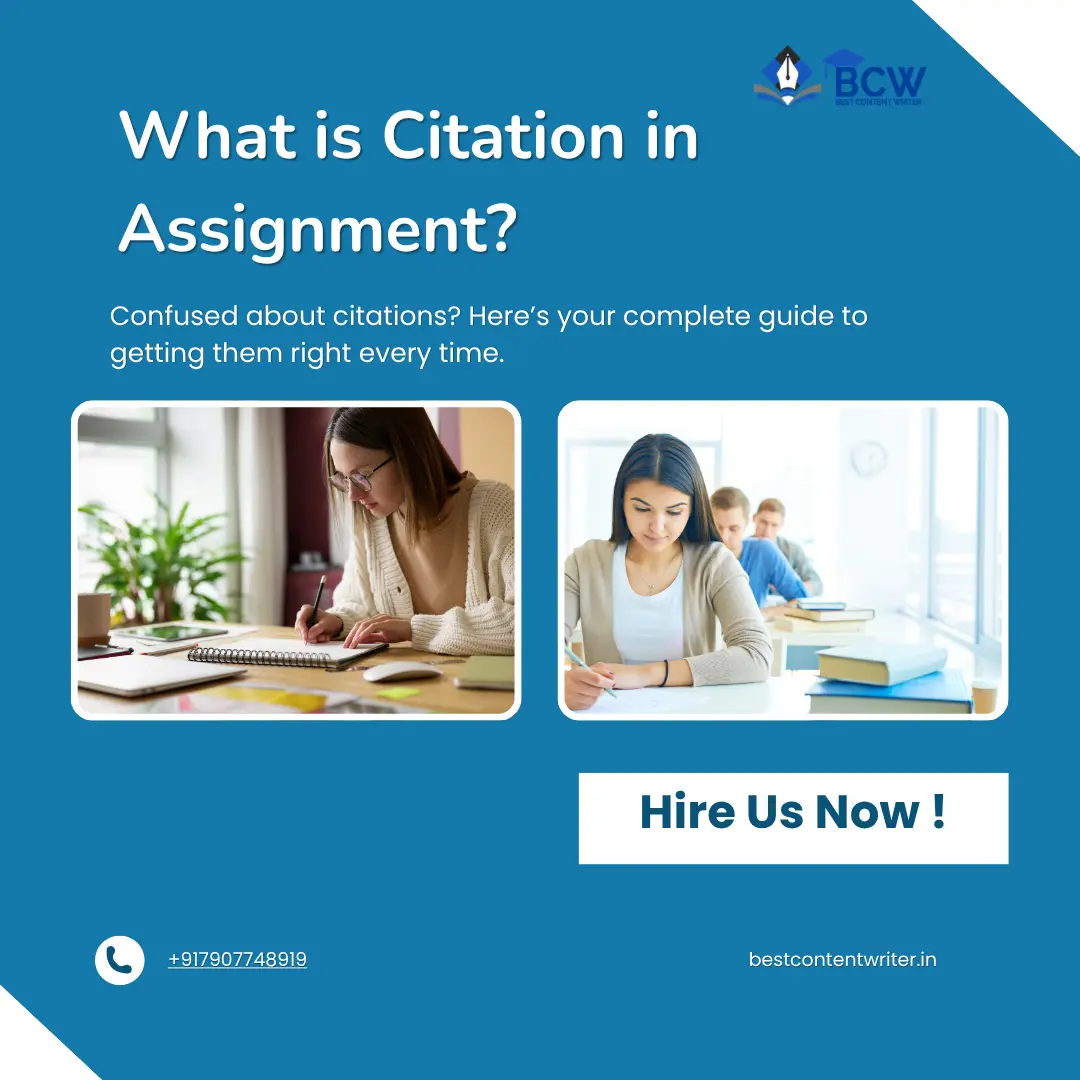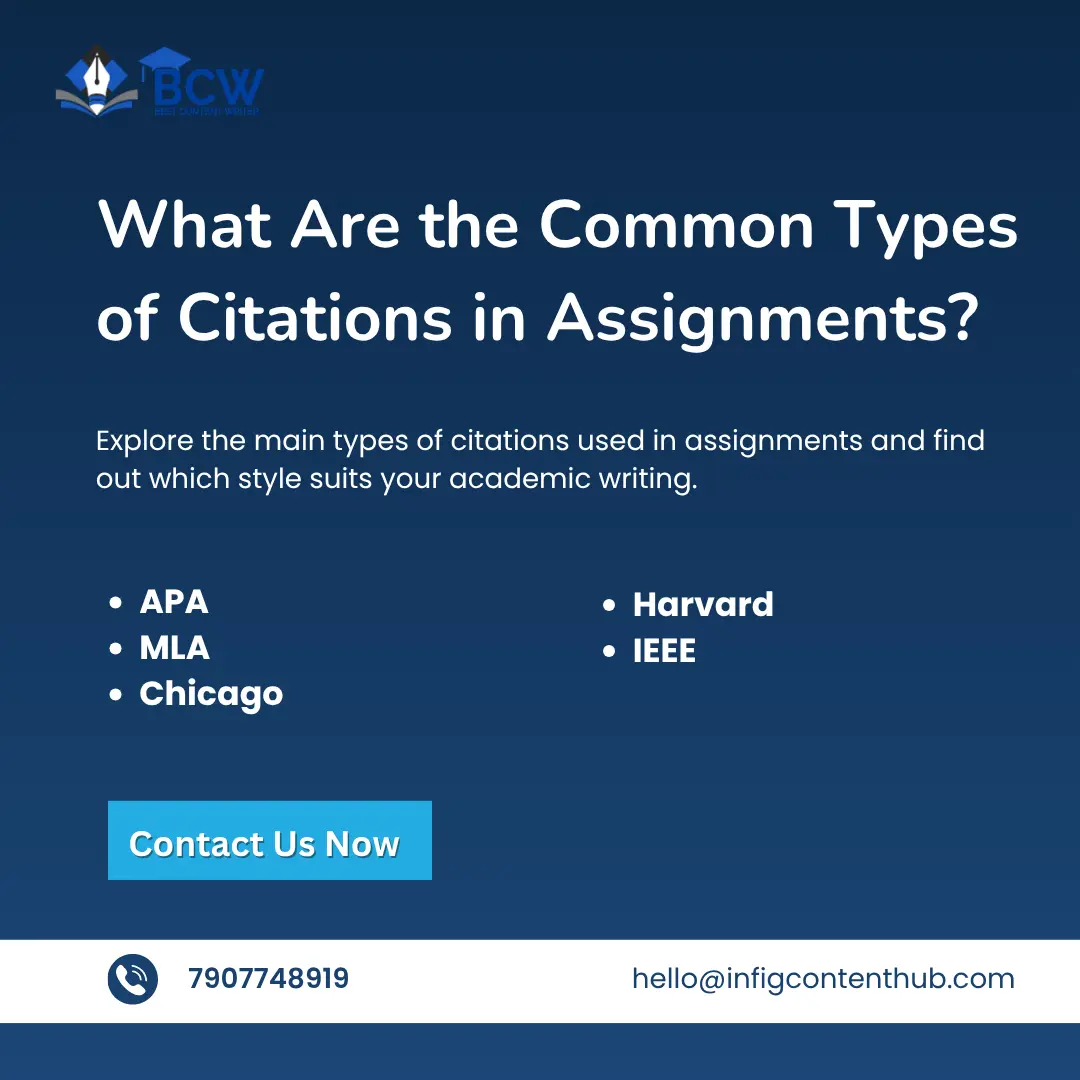What is Citation in Assignment?
Citation in assignments may seem straightforward, but in reality, it involves precise formatting, source tracing, and adherence to specific style guides. It is a crucial elements that determine the credibility of your work. Explore this blog to understand what is citation in assignments means, why it matters, and how to apply the right techniques for accurate academic referencing.

What Does Citation Mean in an Assignment?
Citation in assignment refers to the reference you give for the original source of research, data or concept you have used in the process of developing your paper. An assignment citation consists of the following details:
- Name of the author
- Publication year
- Book Title
- Name of the source (website, book, journal, etc.)
Here is an example that shows how citation in assignment is used in an actual example as per the APA (American Psychological Association) style guide.
In-text citation:
Samuelson & Nordhaus, 2010
Why Is Citation in Assignments Important?
Adding proper citation is essential in assignment writing as it helps you properly credit original sources and thereby maintain your academic integrity. People who read your paper can clearly see your research path. Here are the key reasons that underscore its importance.
Shield Your Work from Plagiarism:
When you add assignment citation, it separates your own ideas from borrowed material. When there is a lack of citation, the presence of borrowed ideas can mean academic theft.
Strengthens Your Voice and Credibility:
Referencing credible sources in your paper is a smart way to build trust in your project. It shows that you have built a strong and solid foundation for your work.
Supports Your Claims:
Whatever claims you make in your assignment need to have essential evidence to back them up. The citations serve that very function neatly, so you don’t risk your points being dismissed as mere opinion.
Upholds Academic Integrity:
One of the core qualities you will need to maintain as an academic writer or student is to demonstrate your ethical commitment to acknowledging the work of other scholars. Citations formalise this.
Creates a Research Trail:
Citation in assignments offers readers a clear pathway to locate your sources for deeper exploration. This research trail also strengthens your work’s credibility by showing that your arguments are grounded in verifiable evidence.
What Are the Common Types of Citations in Assignments?

When you write an academic paper, it is essential to use proper citations. There are multiple types of them, which are recommended for different disciplines with unique formatting rules for in-text citations and reference lists. Here are the most common types:
APA:
APA (American Psychological Association) is the most commonly used assignment citation style across the world. It uses author-date citations with parenthetical references and is commonly used in social sciences, psychology, and education research papers since they require publication dates and empirical sources.
MLA:
Modern Language Association (MLA) format requires author-page citations without publication dates. This style is preferred in humanities, literature, and arts disciplines for essays analysing texts, creative works, and cultural studies.
Chicago:
The Chicago Manual of Style provides writers with two different systems. Notes-bibliography and author-date. If you are working on a research paper in history, philosophy or humanities that demands detailed footnotes, endnotes, and comprehensive bibliographic documentation, this style is ideal to go with.
Harvard:
Harvard referencing style of citation in assignment uses author-date parenthetical system similar to APA. Many British universities require students to use this style across various disciplines. It’s straightforward in-text references and alphabetical reference lists make it easily accessible for both undergraduate and postgraduate students.
IEEE:
IEEE stands for the Institute of Electrical and Electronics Engineers. It employs numbered citations in brackets and is a standard referencing style in engineering, computer science, and technical fields for citing patents, conference proceedings, and technical documentation.
How In-text Citations Differ from Reference Lists?
As you progress in your assignment referencing, one common doubt that may pop up is how in-text citations differ from reference lists. The former appears within the body of your work to briefly acknowledge the sources where information is used, whereas the reference lists are positioned at the document’s end. They are for providing complete bibliographic details of all cited sources.
How to Cite Sources Accurately in Your Assignments – Pro Tips from Our Experts
- Credit sources whether directly quoting, paraphrasing, or summarizing borrowed information.
- Record source details immediately while researching to avoid later hassles.
- Follow your university’s preferred citation format for all assignments consistently.
- Try helpful citation managers like Zotero, Mendeley, or generator tools.
- Verify formatting matches your style guide’s requirements before submitting work.
What Is BCW’s Role in Providing Assignment Help Services?
At Best Content Writer, our skilled assignment writers do more than just complete your tasks they make sure your work looks polished, credible, and ready to impress. Many students get stuck when it comes to citations, unsure which style to use or how to format it correctly. Our writers take that stress away by handling every detail, from accurate in-text references to a well-structured bibliography. Whether it’s APA, MLA, Harvard, or any other style, we make sure your sources are cited the right way. With BCW, you get assignments that read naturally, follow your university’s rules, and show genuine academic effort — not something that feels copy-pasted or machine-made.
Conclusion
Thanks for reading! Mastering the skill of using citation in assignment helps you shield your academic integrity and strengthen your paper’s credibility. We believe this guide helped you clarify your doubts regarding assignment citations. Share your feedback and questions in the comments!
Frequently Asked Questions
Yes. Citations should come within your assignment text/body to credit a source, while the referencing list is to come at the end of the paper to show full publication details.
No, you don’t have to cite common knowledge or widely known facts or universally accepted information. However, if you are uncertain whether what you are citing is common knowledge, it’s safer to cite your source.
There’s no fixed number. It depends on your topic’s depth, the evidence needed, and academic level. We recommend that you always cite enough sources to support every key argument you use in your paper.
Yes, you can cite credible websites without any concerns. However, make sure that you double-check the trustworthiness of the source before proceeding. The use of authoritative and relevant cites, preferably from government, academic, or professional organisations, is highly recommended.
If you are overwhelmed by the volume of assignment citations to properly manage in your project, it is good to use citation tools like Zotero or Mendeley. As you do your research, keep taking notes to keep them organised, and follow one referencing style consistently throughout your assignment to avoid confusion.
Harvard and APA styles are beginner-friendly because they use simple author-date formats and clear rules for both in-text citations and reference lists.
Yes. Citation is essential to acknowledge sources, maintain academic honesty, and prevent plagiarism. Every assignment using external information should include proper citations.

Anto Francis
Anto Francis is an academic writer with about a decade of experience behind him. Before becoming a full-time writer with us, he worked as an English Language Instructor in the Republic of Maldives. During the tenure he had helped thousands of students globally with a wide array of documents including SOP, LOR, personal statement, motivation letter and admission essays.
